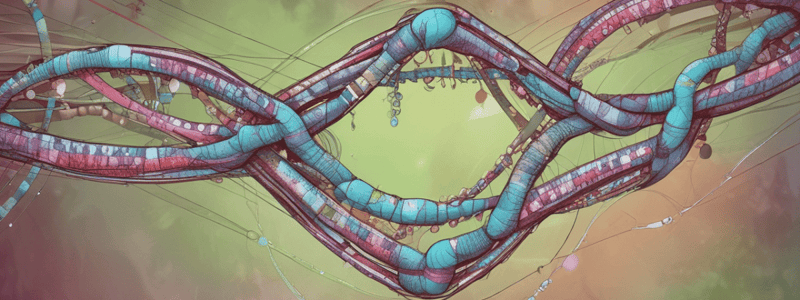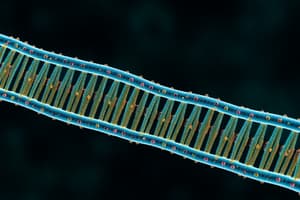Podcast
Questions and Answers
What is the result of exon skipping in the CD45 gene?
What is the result of exon skipping in the CD45 gene?
- Regulation of transcriptional initiation
- Inclusion of premature stop codons in the final mRNA transcript
- Production of different protein isoforms with distinct functions (correct)
- Production of a single protein isoform
What is the mechanism by which the human calcitonin gene produces different transcripts in different tissues?
What is the mechanism by which the human calcitonin gene produces different transcripts in different tissues?
- Alternative promoter usage (correct)
- Exon skipping
- Splicing factor regulation
- Intron retention
At which levels can alternative splicing be regulated?
At which levels can alternative splicing be regulated?
- Transcriptional, post-transcriptional, and epigenetic levels (correct)
- Epigenetic level only
- Post-transcriptional level only
- Transcriptional level only
What is the function of splicing factors in alternative splicing?
What is the function of splicing factors in alternative splicing?
What is the result of intron retention in the survival motor neuron 1 (SMN1) gene?
What is the result of intron retention in the survival motor neuron 1 (SMN1) gene?
What is the role of CELF proteins in alternative splicing?
What is the role of CELF proteins in alternative splicing?
What is the outcome of alternative splicing?
What is the outcome of alternative splicing?
Which factor influences the order of intron elimination?
Which factor influences the order of intron elimination?
What is the primary transcript in RNA processing?
What is the primary transcript in RNA processing?
What is the primary reason for the existence of many introns in eukaryotic genomes?
What is the primary reason for the existence of many introns in eukaryotic genomes?
What is the consequence of the spliceosome not acting canonically?
What is the consequence of the spliceosome not acting canonically?
What happens to the exons that are 'skipped' during alternative splicing?
What happens to the exons that are 'skipped' during alternative splicing?
What is the general direction of intron elimination?
What is the general direction of intron elimination?
What is the consequence of retaining an intron in the mature mRNA, if the intron sequence does not have a reading frame?
What is the consequence of retaining an intron in the mature mRNA, if the intron sequence does not have a reading frame?
What is the effect of efficient co-transcriptional splicing?
What is the effect of efficient co-transcriptional splicing?
What is the typical mechanism of alternative splicing?
What is the typical mechanism of alternative splicing?
Which of the following does not affect the order of intron elimination?
Which of the following does not affect the order of intron elimination?
Why is the rapid elimination of introns not always observed?
Why is the rapid elimination of introns not always observed?
What is the result of regulated splicing?
What is the result of regulated splicing?
What is the result of including an intron sequence in the mature mRNA, if the sequence has a reading frame?
What is the result of including an intron sequence in the mature mRNA, if the sequence has a reading frame?
What is the purpose of alternative splicing in eukaryotic organisms?
What is the purpose of alternative splicing in eukaryotic organisms?
What is the consequence of including a 'megaintron' in the mature mRNA?
What is the consequence of including a 'megaintron' in the mature mRNA?
What is the main difference between alternative splicing and RNA editing?
What is the main difference between alternative splicing and RNA editing?
What is the role of nucleosomas in alternative splicing?
What is the role of nucleosomas in alternative splicing?
What is the effect of high polymerase velocity on splicing?
What is the effect of high polymerase velocity on splicing?
What is the function of 5-methylcytosine in alternative splicing?
What is the function of 5-methylcytosine in alternative splicing?
Why are some introns not perfect?
Why are some introns not perfect?
What is the result of alternative splicing in the Drosophila axon guidance receptor?
What is the result of alternative splicing in the Drosophila axon guidance receptor?
What is the role of RNA polymerase II in alternative splicing?
What is the role of RNA polymerase II in alternative splicing?
Why is it not possible to achieve perfect regulation with perfect introns?
Why is it not possible to achieve perfect regulation with perfect introns?
What is the effect of reducing the velocity of RNA polymerase II on splicing?
What is the effect of reducing the velocity of RNA polymerase II on splicing?
Flashcards are hidden until you start studying
Study Notes
Alternative Splicing
Exon Skipping
- A mechanism of alternative splicing where one or more exons are omitted from the final mRNA transcript
- Can result in the production of different protein isoforms with distinct functions
- Can be regulated by splicing factors and other trans-acting elements
- Example: exon skipping in the CD45 gene results in different isoforms with varying cellular distributions
Alternative Promoter Usage
- Refers to the use of different promoters to initiate transcription of the same gene
- Can result in different first exons being included in the final mRNA transcript
- Can be regulated by transcription factors and other cis-acting elements
- Example: the human calcitonin gene uses alternative promoters to produce different transcripts in different tissues
Regulation of Alternative Splicing
- Alternative splicing can be regulated at multiple levels, including transcriptional, post-transcriptional, and epigenetic levels
- Splicing factors, transcription factors, and other regulatory elements can affect alternative splicing patterns
- Cellular context, including cell type, differentiation state, and environmental cues, can also influence alternative splicing
Splicing Factors
- Proteins that bind to specific sequences in pre-mRNA to regulate alternative splicing
- Can act as activators or repressors of splicing
- Examples of splicing factors include SR proteins, hnRNP proteins, and CELF proteins
- Splicing factors can interact with each other and with other regulatory elements to modulate alternative splicing
Intron Retention
- A mechanism of alternative splicing where an intron is retained in the final mRNA transcript
- Can result in the inclusion of premature stop codons, leading to nonsense-mediated decay or the production of truncated proteins
- Can be regulated by splicing factors and other trans-acting elements
- Example: intron retention in the survival motor neuron 1 (SMN1) gene leads to the production of a truncated protein associated with spinal muscular atrophy
Studying That Suits You
Use AI to generate personalized quizzes and flashcards to suit your learning preferences.




